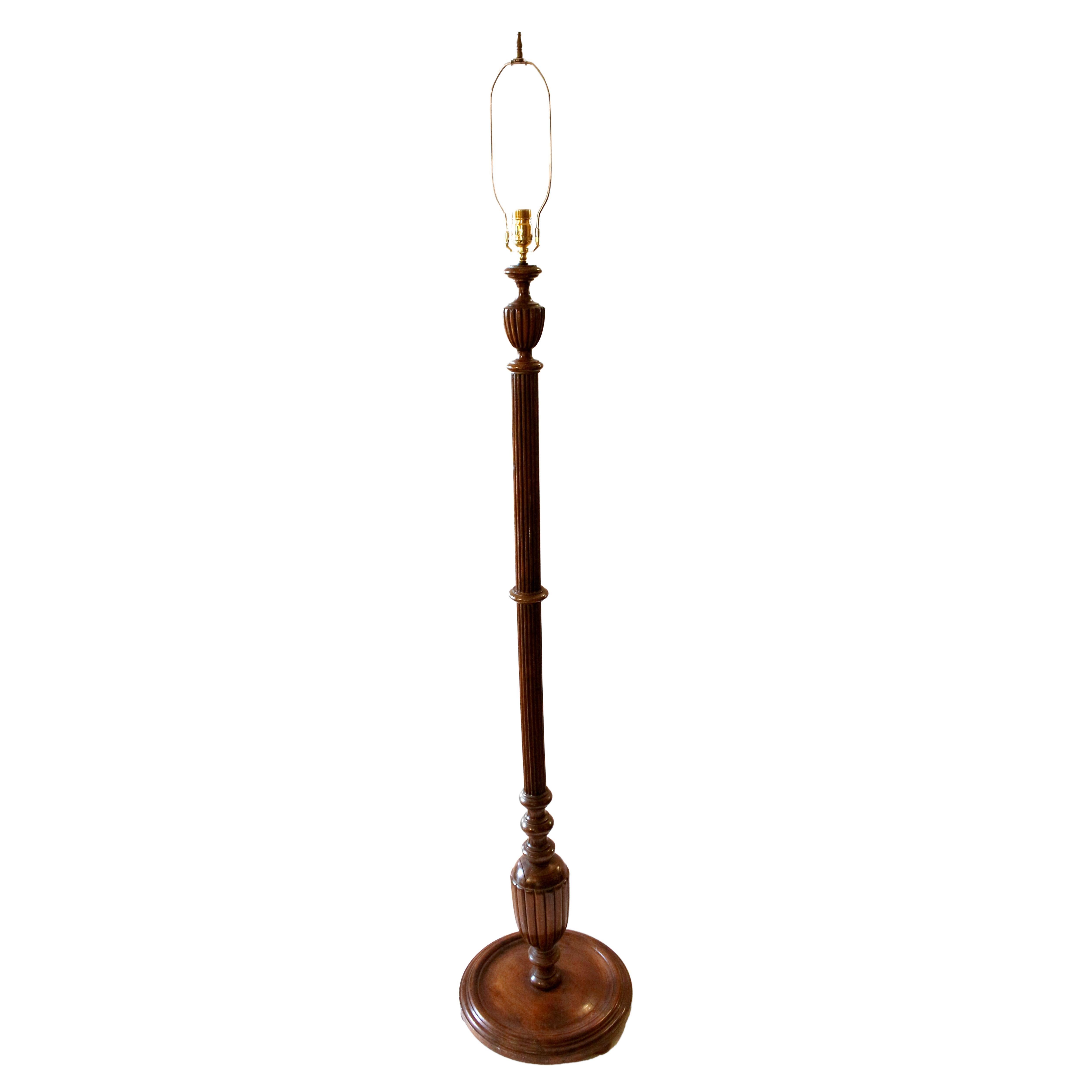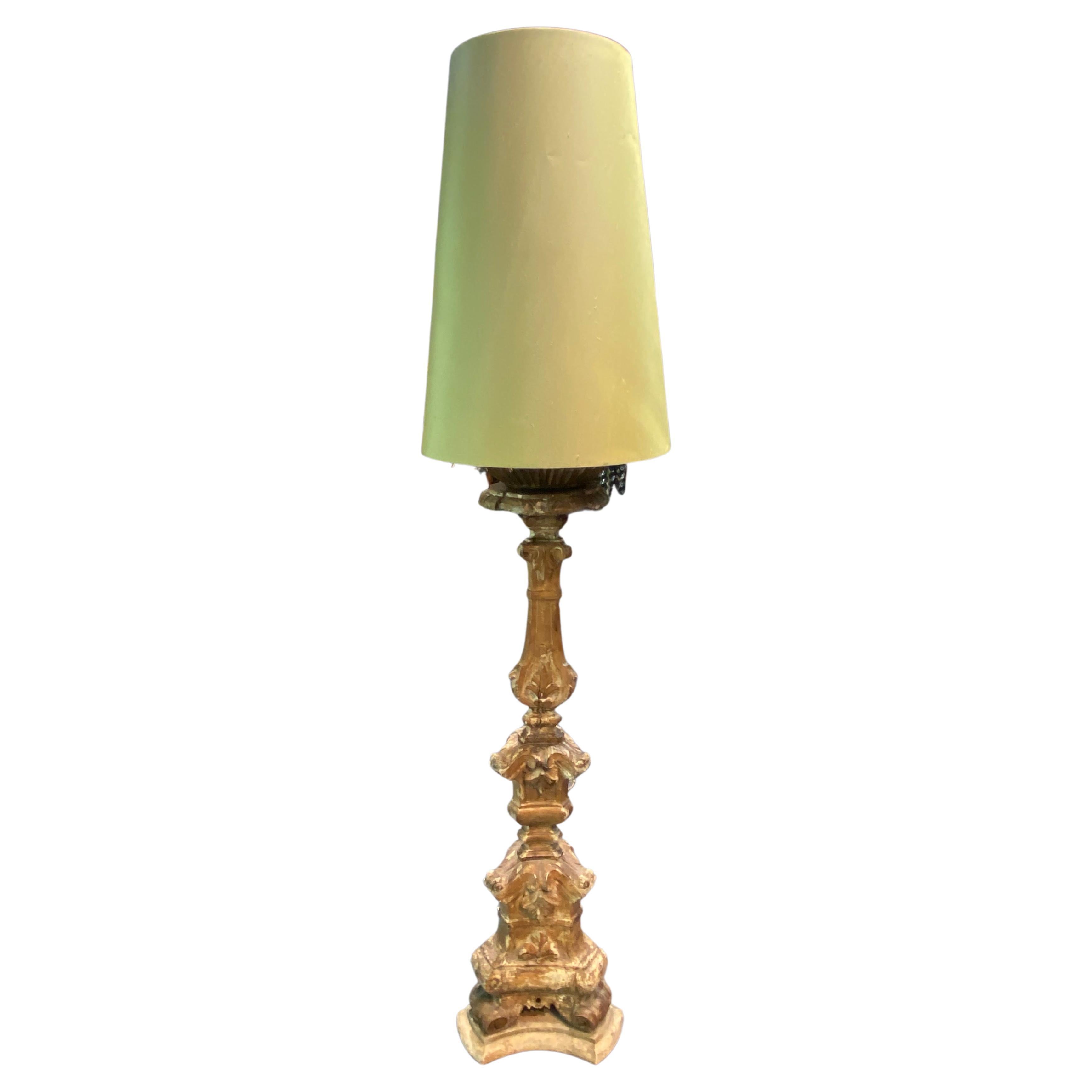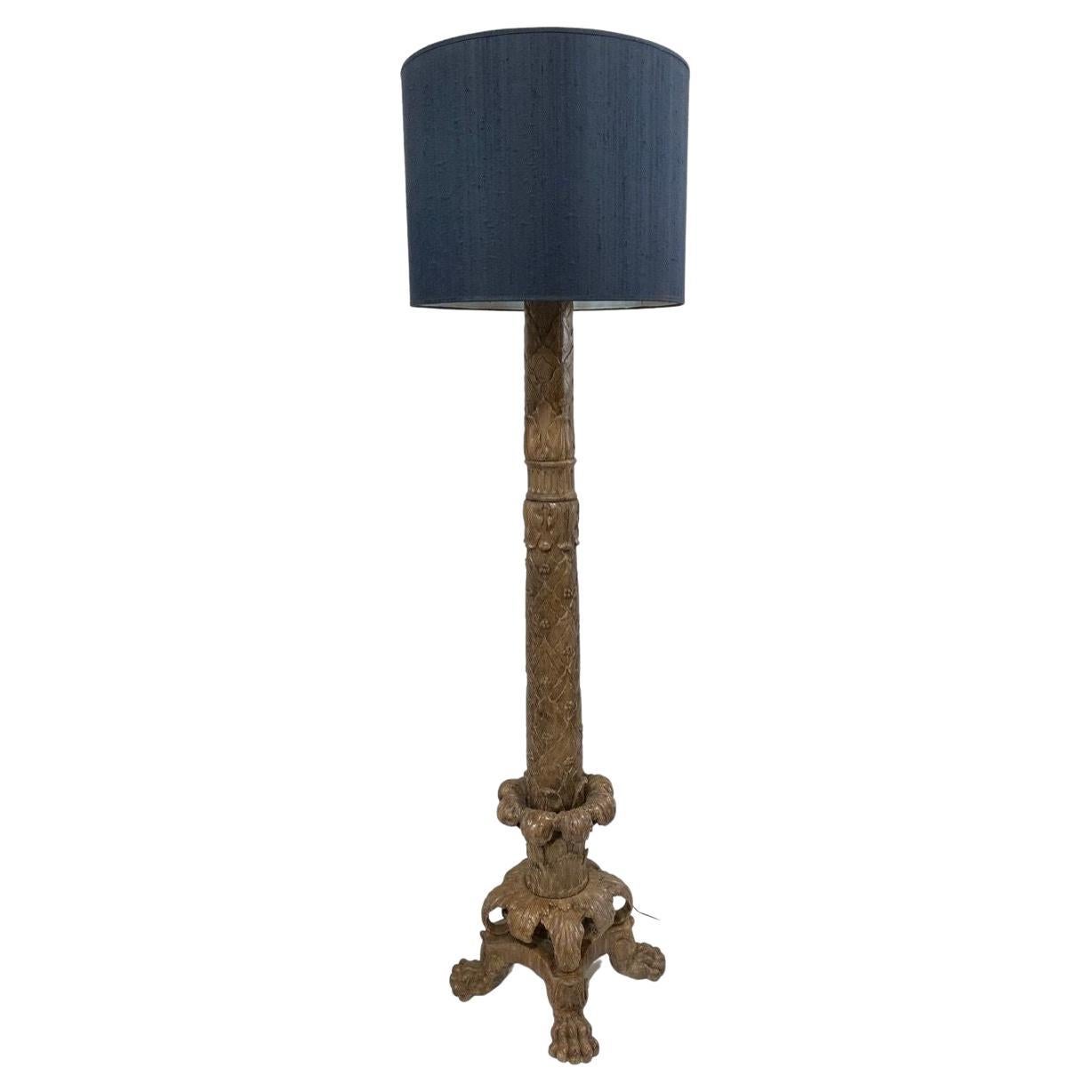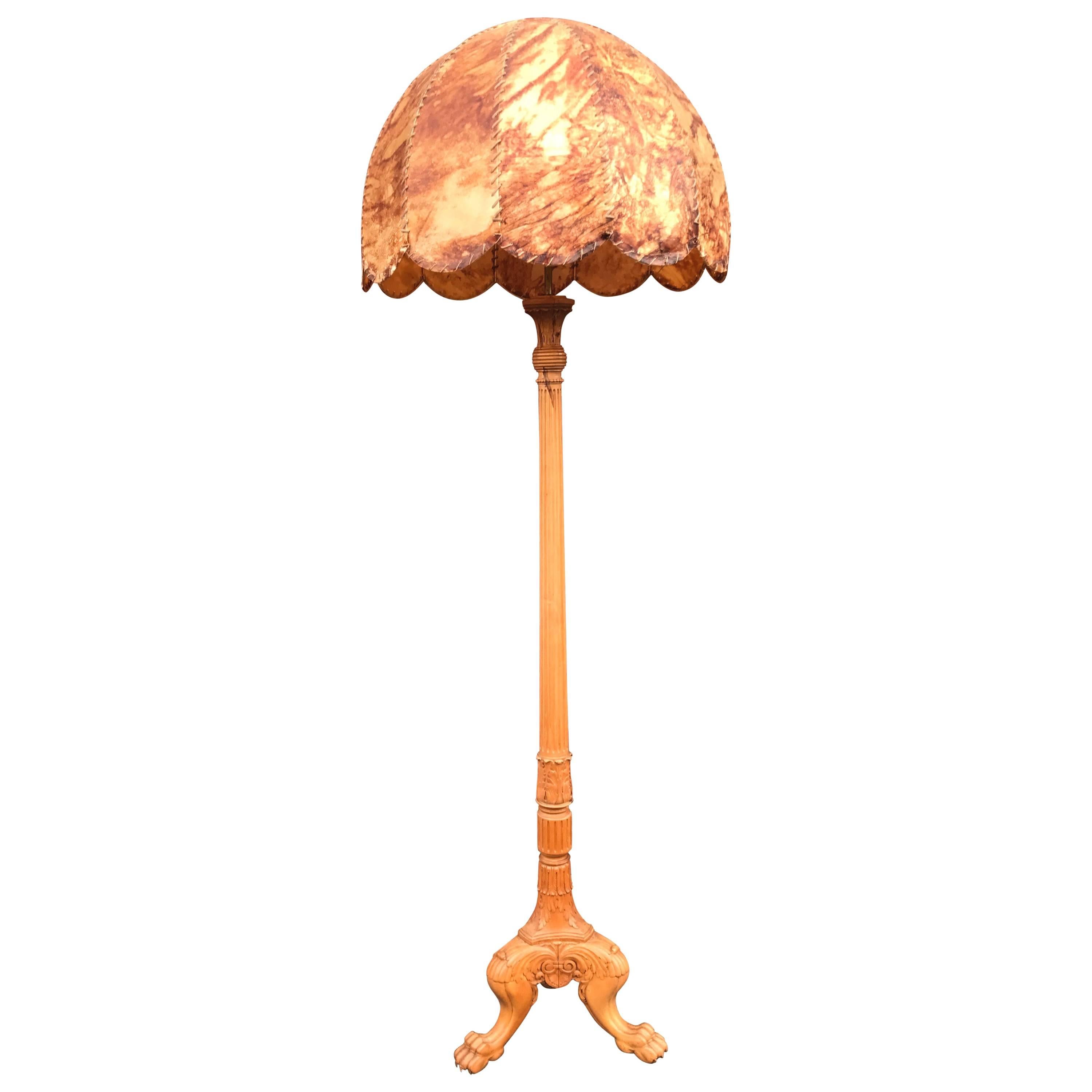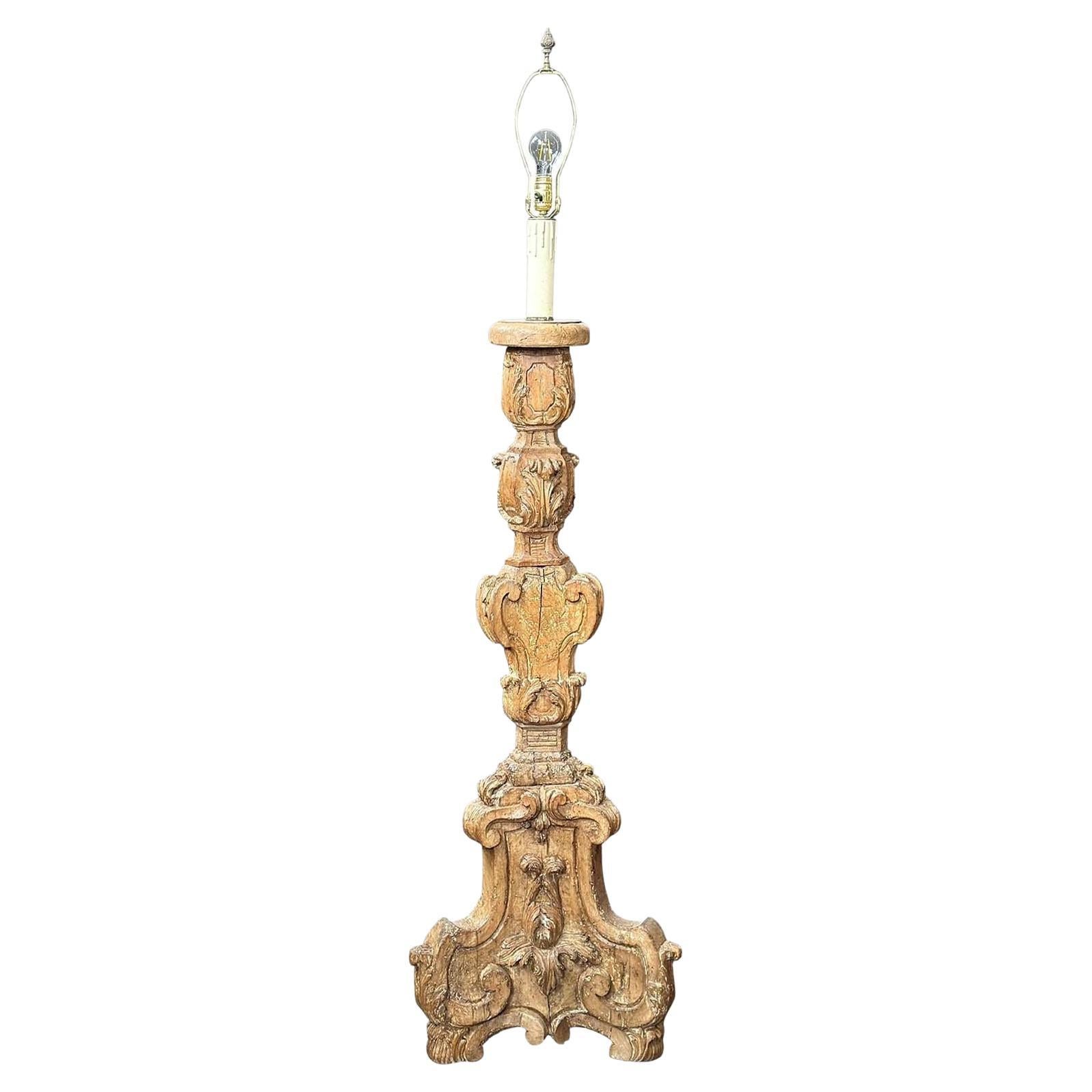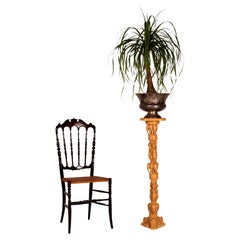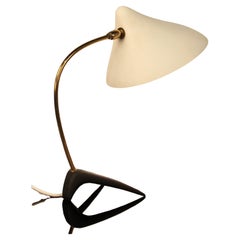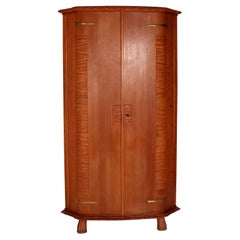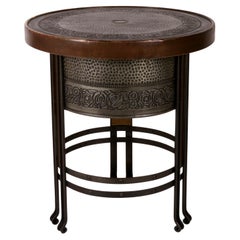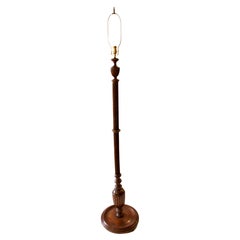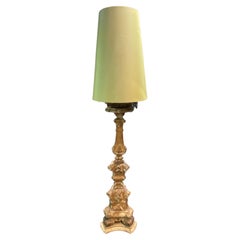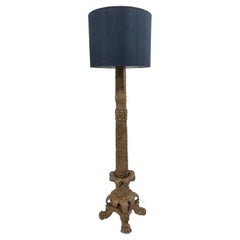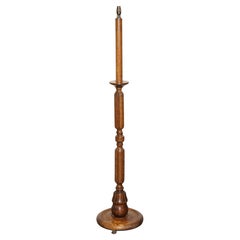Items Similar to Unique and antique Austrian floor lamp stand, carved and turned : solid oak wood
Want more images or videos?
Request additional images or videos from the seller
1 of 21
Unique and antique Austrian floor lamp stand, carved and turned : solid oak wood
$8,111.80
£5,997.16
€6,800
CA$11,157.65
A$12,402.43
CHF 6,501.09
MX$151,463.63
NOK 81,162.31
SEK 76,358.59
DKK 51,768.29
About the Item
This is an exceptional example of a late 19th-century floor lamp.
The floor lamp base, dating from the late 1860s or early 1870s, is exquisitely carved and turned.
The structural composition of the lamp is characterised by the integration of four seamlessly connected components.
The components are arranged from the base to the top as follows:
A: A base that has been intricately carved with large acanthus leaves.
B: A column that has been carved with equal elaboration, displaying elements of Art Nouveau, and is adorned with another rosette in floral leaf acanthus.
C: A central element in the form of an elegantly designed ball.
D: An upwardly tapering turned continuation, ending with a floral crown at the top and forming the base for the iron holder of two E27 sockets and on the very top the holder for the lamp shade.
~~~~~~~~~~~~~~~~~~
The lamp stand has a height of 1 m and 66 cm. Weight: 10.7Kg.
The diameter of the base is 38 cm at its maximum point.
Two E27 lamp sockets are provided, and they are compatible with light bulbs of both 110/120V and 220/240V.
The lamp is rewired with a black textile cable and a foot switch.
- Dimensions:Height: 65.36 in (166 cm)Diameter: 14.97 in (38 cm)
- Lampshade:Not Included
- Style:Victorian (Of the Period)
- Materials and Techniques:
- Place of Origin:
- Period:
- Date of Manufacture:1860s-1870s
- Condition:Rewired. Wear consistent with age and use.
- Seller Location:Landshut, DE
- Reference Number:1stDibs: LU8587244028902
About the Seller
5.0
Vetted Professional Seller
Every seller passes strict standards for authenticity and reliability
1stDibs seller since 2023
21 sales on 1stDibs
- ShippingRetrieving quote...Shipping from: Bodenkirchen , Germany
- Return Policy
Authenticity Guarantee
In the unlikely event there’s an issue with an item’s authenticity, contact us within 1 year for a full refund. DetailsMoney-Back Guarantee
If your item is not as described, is damaged in transit, or does not arrive, contact us within 7 days for a full refund. Details24-Hour Cancellation
You have a 24-hour grace period in which to reconsider your purchase, with no questions asked.Vetted Professional Sellers
Our world-class sellers must adhere to strict standards for service and quality, maintaining the integrity of our listings.Price-Match Guarantee
If you find that a seller listed the same item for a lower price elsewhere, we’ll match it.Trusted Global Delivery
Our best-in-class carrier network provides specialized shipping options worldwide, including custom delivery.More From This Seller
View Allextremely rare Flower Stand pedestal faux ivory stone Oriental Victorian Style
Located in Landshut, BY
An extremely rare
Flower Stand Pedestal
Erotic Oriental Victorian style
Imitation Ivory
This is an original piece made in Italy in the 1960s.
The statue is made from a mixture ...
Category
Vintage 1960s Italian Victorian Pedestals and Columns
Materials
Marble
classic Louis Kalff table lamp for Philips CROW FOOT beautifully preserved
By Louis Christiaan Kalff
Located in Landshut, BY
Louis Kalff table lamp Mid century
Beautifully preserved Crow's foot table lamp from the 1950s, designed by Louis Kalff for Philips.
Classic textured lacquer fully functional and usable.
E27 socket - can be used both with 220/240 V or 110/150 V bulbs
Louis Christiaan Kalff (14 November 1897 in Amsterdam - 16 September 1976 in Waalre) was a Dutch designer. After graduating from secondary school, Kalff studied at the Quellinus School in Amsterdam (now the Gerrit Rietveld Academie) and at the Technical University of Delft.
Between 1925 and 1926, together with Jan Hanrath, Kalff designed the building of the Delft Student Rowing Association (D.S.R.V. Laga) in the style of the Amsterdam School.
In 1925, Kalff joined the Philips advertising department. Under his direction, the Lighting Advice Bureau (LIBU) was established in 1929. He designed the Philips logo and participated in the World Expositions in Barcelona, Antwerp, Brussels and Paris. He also designed posters and printed advertisements for the Holland-America Line, the Calvé company, the seaside resort of Scheveningen and Holland Radio. He also designed book covers.
Kalff also worked for Philips as an architect on buildings such as the Dr A.F. Philips Observatory in Eindhoven (1937), the Diamond Court in Valkenswaard (1948) and several country houses for Philips directors in Eindhoven and Waalre.
Kalff continued to work for Philips as a product designer after the Second World War. For the Philips pavilion...
Category
Mid-20th Century Italian Mid-Century Modern Table Lamps
Materials
Iron, Sheet Metal
Colli Torino (Est. 1850) Art Nouveau Italian Corner Cabinet Wardrobe Solid Oak
By Colli Torino
Located in Landshut, BY
This corner wardrobe was produced by Colli Torino established in 1850.
- solid oak with hand carved elements and beautiful brass fittings with its original key -
The company is we...
Category
Vintage 1910s Italian Art Nouveau Cupboards
Materials
Brass
an extremely rare French Art Nouveau side table Paris ar. 1905 iron brass zinc
By Hector Guimard
Located in Landshut, BY
Bonjour !
This object is a gem, and in this rare version it features a riveted wrought iron frame with hammered zinc sheet fixed to a wooden panel. The panel has artistically desig...
Category
Antique Early 1900s French Art Nouveau Side Tables
Materials
Iron, Brass, Zinc
Anders Pehrson Ateljé Lyktan SWEDEN set of 5 floor lamps f. Olympia 1972 Munich
Located in Landshut, BY
Anders Pehrson for Ateljé Lyktan
FLOOR LAMP "OLYMPIA"
set of five floor lamps
recommended with 2 E14 bulbs 25W and 40W as the lamp can be switched in...
Category
Vintage 1970s Swedish Mid-Century Modern Floor Lamps
Materials
Metal
Colli Torino 'Est. 1850 ' Italian Art Nouveau Bed & Nightstand Solid Oak carved
By Colli Torino
Located in Landshut, BY
This bed and night stand was produced by Colli Torino established in 1850.
- solid oak with hand-carved elements - mattress size is 120cm x 190cm -
The company is well known becau...
Category
Vintage 1910s Italian Art Nouveau Beds and Bed Frames
Materials
Oak
You May Also Like
Early 20th Century Carved Wood Floor Lamp, English
Located in Chapel Hill, NC
Early 20th century carved wood floor lamp, English. Likely made from a much earlier bed post or torchiere. Mahogany. The shaft well reeded ending in bulbous turnings and disc base. S...
Category
Early 20th Century English Rustic Floor Lamps
Materials
Wood
$580 Sale Price
20% Off
19th Century, French, Large Hand Carved Tripod Wooden Floor Lamp
Located in Sofia, BG
Late 19th century church torchère converted to floor lamp on a tripod base made of hand carved wood 150 cm. high with 60 cm shadow.
France, circa 1890.
Category
Antique Late 19th Century Floor Lamps
Materials
Wood
Vintage Italian Baroque Style Hand Carved Wood Floor Lamp
Located in Van Nuys, CA
A magnificent large-scale 1950s Italian floor lamp styled after the 18th-century Baroque period. The lamp features beautifully done hand-carved details including ion paw-shaped feet with large acanthus leaves at the square base. The impressive central supports display stunning arrays of richly carved designs with foliate designs and lovely scrolled movements.
The lamp is excellent in all original condition with a vintage black lamp...
Category
Vintage 1950s American Mid-Century Modern Floor Lamps
Materials
Wood
$1,650 Sale Price
40% Off
ANTIQUE CIRCA 1910 SOLID OAK STANDARD FLOOR LAMP WiTH ROUND BASE
Located in Pulborough, GB
Antiques of London
Add timeless charm and warm character to your home with this vintage hand-turned wooden floor lamp, a classic piece that blends traditional craftsmanship with ...
Category
20th Century British Floor Lamps
Materials
Oak
Stunning Hand Carved Antique Floor Lamp on Tripod Claw Feet with Leather Shade
Located in Lisse, NL
Early 1900s fruitwood floor lamp with detailed carvings.
This antique and finely carved floor lamp is rare both in shape and color. The wonderful tripod base consist of three impres...
Category
Early 20th Century Dutch Arts and Crafts Floor Lamps
Materials
Leather, Wood
18th Century Italian Hand-Carved Floor Lamp
Located in Los Angeles, CA
Stunning Italian hand-carved floor lamp from the 18th Century. UL Listed (rewired to fit US Standards).
Dimensions:
76.5"H x 20.5"D.
Category
Antique 18th Century Italian Floor Lamps
Materials
Wood
More Ways To Browse
Lamp Stands
Turn Of The Century Lighting
Turn Of The Century Lamps
Turned Wood Stand
Antique Lamp Sockets
Antique Lamp Stands
Antique Austrian Lamp
Turned Wood Columns
Antique Lamp Carved Wood
Austrian Carved Wood
Antique Lamps 1870
Acanthus Leaf Lamp
Antique Wood Lamp Stand
Art Nouveau Display Stand
Large Victorian Lamps
Austrian Art Nouveau Lamp
Solid Turned Wood Lamp Base
Eskilstuna Elektrofabrik Ab
